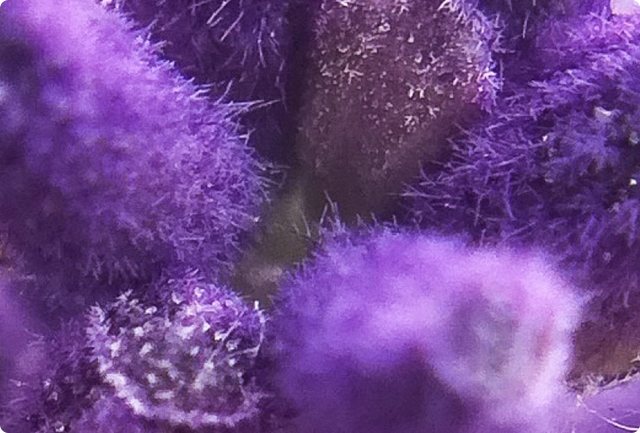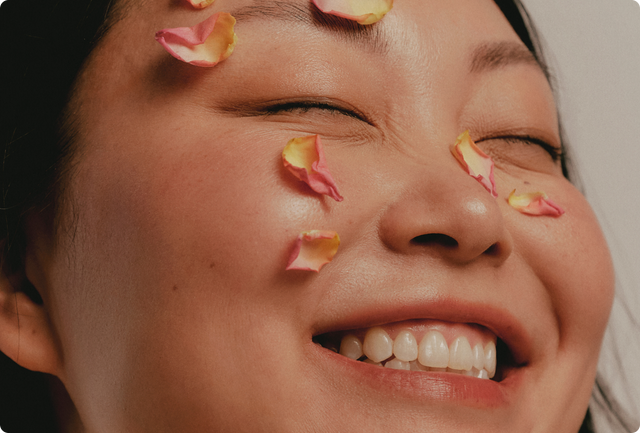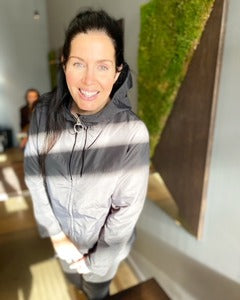ESSENTIAL OILS AND CHILDREN
Here at Saje, we’re very commonly asked questions related to essential oil usage for babies and children. While the answer is not always as simple as yes or no, we do our best to share the most accurate and up to date information available in the aromatherapy industry related to safety and efficacy, in accordance with the top safety experts in the business.
Our intent with this blog is to provide the ‘why’ behind certain usage instructions, product recommendations and suggested wait times for some of our most popular products and different ingredients.
It is imperative that you are your own biggest health advocate, and that you have autonomy when choosing products to use that support your wellness and the wellness of your babies and children. Our #1 suggestion will always be to speak to a trusted healthcare professional or medical practitioner who knows you and your family well, who knows any of your children’s underlying health conditions or predispositions, and who can help debunk any myths or stereotypes when it comes to certain essential oils or ingredients during infancy and through childhood. All of the ingredients we use and instructions we recommend adherence to are listed on our product labels, and we suggest you discuss these with a healthcare professional prior to use.
BEST PRACTICES FOR USING ESSENTIAL OILS WITH BABIES & CHILDREN
We recommended careful and informed use of essential oils especially during the younger years of life. We are also respectful of parents and recognize that the ultimate responsibility and decision on product use remains with the parent. To assist our Community Members who are comfortable using our products for their children, we will share some of the best advice we have in terms of making product recommendations and in creating the conditions for maximum safety and efficacy. Some of our best practices are as follows:
- ALWAYS READ THE PRODUCT LABEL: Always read the product label to see if there are any safety precautions noted on the package. Except for blends created especially for babies and children, products considered Natural Health Products (NHP) in Canada and Over The Counter products (OTC) in the United States are licensed for adult use only, and are labelled accordingly. Special instructions for use also appear on some Cosmetic and Consumer Products.
- STORE PROPERLY & SAFELY: Always store essential oils out of reach of children with the container tightly closed, and in a child-safe place.
- DO NOT INGEST: children (and adults) should not ingest essential oils. If ingestion does occur, it is our strong recommendation to contact your nearest Poison Control Centre immediately.
- DILUTE IN A CARRIER OIL: when using essential oils, always dilute with a carrier oil before applying to the skin. Undiluted (or ‘neat’) oils should never be used on children or infants.
- APPLY AWAY FROM MUCOUS MEMBRANES: keep essential oil products away from the mucous membranes (eyes, nose and mouth). If contact occurs, flush the area with carrier or vegetable oil to dilute. Using water can cause further irritation, so we recommend plant based carrier oils like coconut oil, jojoba or any other vegetable oil.
- FOLLOW THE GOLDEN RULE OF 'LESS IS MORE': if you would like to use essential oils with your children, education is key and we recommend using less products of all types around babies and children.
FREQUENTLY ASKED QUESTIONS FOR ESSENTIAL OIL USAGE WITH CHILDREN
Below we’ve compiled a non-exhaustive list of questions we hear commonly when it comes to using essential oils and essential oil-based products on babies and children.
Q: WHICH PRODUCTS CAN I USE ON MY BABY AND YOUNG CHILD?
A: To keep your little one safe, for a newborn to 24 months we recommend that you always check with your paediatrician before introducing a new product to your baby’s routine. We also advise speaking with an aromatherapist trained in safe use of essential oils for children and babies prior to use.
Q: ARE DIFFUSERS A SAFE WAY OF INTRODUCING ESSENTIAL OILS TO CHILDREN?
A: Ultrasonic diffusers are effective for enhancing the air of an environment like a bedroom, playroom or daycare facility. We recommend these best practices that align with aromatherapy safety expert Robert Tisserand and his recommendations:
- Less is more: use 1-3 drops in your ultrasonic diffuser
- Intermittent setting: if you are diffusing essential oils, use an intermittent setting instead of a continuous run (for example, a diffuser like our Aroma Om that can run for 30 seconds on, 30 seconds off for up to six hours)
- Diffusion time: diffuse essential oils for 30-60 minutes on, then 30-60 minutes off
- Air flow: whenever you are using or diffusing essential oils, offer fresh air with an open window or door
Q: MY BABY OR YOUNG CHILD HAS A COLD. CAN I USE PRODUCTS FROM YOUR COUGH & COLD LINE?
A: Our Immune product line is licensed by Health Canada for safe use by adults. In the US, our full cough and cold product line (Fortify oil blend, Sweet Comfort oil blend, and Chest Comfort balm) can be used by children 12 years of age and older. However, we also offer in both countries our gentle and renewing Fortify Petite Diffuser Blend, a product formulated to soothe and support your little one’s wellness when diffusing this child-friendly blend of refreshing tea tree, calming lavender and clearing myrtle.
Q: I HAVE A DIFFUSER; ARE THERE BLENDS I SHOULD AVOID USING WITH BABIES OR CHILDREN IN HY HOME?
A: Remember to read product labels carefully, as some products may not be appropriate for children (or adults) with asthma, epilepsy or other special health concerns. Ingredients in these blends may not be safe for infants. We strongly recommend to avoid the use of essential oils that are high in 1,8 cineole, which includes (but is not limited to) eucalyptus, peppermint, rosemary and sage, as these oils are considered too potent for use with young children and babies. As always, our strongest recommendation is to consult a trusted healthcare professional and to remember the golden rule that ‘less is more’. (More information on this below).
Q: CAN I USE YOUR HOME CARE PRODUCTS (LIKE ROOM SPRAYS OR THE HOME CLEANING LINE) IN THE SAME HOME OR ROOM AS MY BABY?
A: Our home care products have no specified age range, however, remember to spray products well away from your infant and child. You may also wish to use these products while your baby is in another room. We recommend that you do not use these sprays on any articles of clothing, toys etc. that may be placed in the infant’s mouth.
Q: CAN I USE NATURAL HEALTH PRODUCTS OR AN OVER THE COUNTER PRODUCT (ROLL ON'S, MISTS, BATH SALTS, BODY OILS) ON MY BABY?
A: Generally, our NHPs and OTCSs are for adult use only and occasionally for children over the age of 12. Unless a natural health product or OTC is specifically made for infants and children, we generally do not recommend using these products on infants or children. Remember to read the label carefully for each product in question prior to use.
Q: CAN I USE COSMETIC PRODUCTS LIKE BODY WASHES, SOAPS, AND NON-REMEDIAL LOTIONS ON MY BABY?
A: Whenever possible, we recommend using products with very little essential oils included in the formula or those that are considered scent-free.
Q: WHICH DIFFUSER BLENDS CAN I USE AROUND MY CHILD?
A: Depending on the age of the child there are several options. When deciding on appropriate blends for babies/children, we refer to expert opinions like Robert Tisserand and select products that consist only of oils that are generally considered safe. (More information on this below).
Q: WHICH PRODUCTS CAN OLDER CHILDREN USE?
A: In addition to all products for ages 6 and up, older children can use many diffuser blends. Most cosmetic lotions, soaps and body washes and non-NHP or OTC mists can also be enjoyed. When trying products with a higher percentage of essential oils like peppermint or spearmint oil, these products can have a “tingle” effect, so it may be best avoided on children who are more sensitive to this sensation. As for younger children, be sure to check warnings for epilepsy and other health concerns.
Q: WHICH PRODUCTS CAN MY TEENAGER USE SAFELY?
A: Teens can use all non-NHPs in Canada and non-OTC products in the USA. Most NHPs in Canada have been authorized for use by their respective Regulatory bodies for adults only.
Q: MY TEEN HAS A COLD, WHICH DIFFUSER BLENDS WOULD YOU RECOMMEND?
A: Many diffuser blends are popular for comforting, soothing, and encouraging deep breathing. Favourites include Rain Forest Renewing Diffuser Blend and Deep Breath Revitalizing Diffuser Blend.
PRODUCTS WE RECOMMEND FOR USE WITH BABIES AND CHILDREN
Below are some of the product recommendations we have for safe, informed use of essential oils in the presence of babies and children:
NEWBORNS - 3 MONTHS OF AGE:
- Use ultrasonic diffusers with only water
- Lavender Mist or Rose Mist: shake well and mist lightly over bedding
- Unscented products like Jojoba oil for bath, body and massage
3 MONTHS - 2 YEARS OF AGE:
- Use ultrasonic diffusers on an intermittent setting (30 seconds on, 30 seconds off) for up to 1 hour with 1-3 drops of the following diffuser blends:
- Lavender Mist, Rose Mist and Fairy Mist Children’s Aromatherapy Spray: shake well and use lightly in the air around babies/children (avoid spraying on items that may be placed into the mouth)
- Unscented Jojoba bath & body massage oil
2 YEARS - 6 YEARS OF AGE:
- Use ultrasonic diffusers on an intermittent setting (30 seconds on, 30 seconds off) for up to 1 hour with 1-5 drops of any of the diffuser blends above. May introduce other diffuser blends such as:
- Aroma Fairy Diffuser Blend
- Fortify Petite Diffuser Blend
- Goddess Diffuser Blend
- Liquid Sunshine Diffuser Blend
- Tranquility Diffuser Blend
- Unwind Diffuser Blend
- Yoga Diffuser Blend
- Lavender Mist, Rose Mist and Fairy Mist Children’s Aromatherapy Spray: shake well and use lightly in the air around babies/children (avoid spraying on items that may be placed into the mouth)
- Unscented jojoba bath & body massage oil
- Aroma Fairy - children’s calming blend for children 2+ years of age with proper adult supervision
- Hand Sanitizer - for children 2+ years of age with proper adult supervision
6 YEARS - 12 YEARS OF AGE:
- Use ultrasonic diffusers on an intermittent setting (30 seconds on, 30 seconds off) with 1-6 drops of any diffuser blends listed above. May introduce other diffuser blends such as:
- All mists excluding products that are NHPs in CAN or OTCs in the USA
- Unscented jojoba bath & body massage oil
- All bar soap, foaming soap and body washes
- All lotions excluding products that have an NPN or an OTC designation
SOURCE OF INFORMATION FOR ESSENTIAL OIL SAFETY FOR BABIES AND CHILDREN
Children represent a special type of Saje Community Member and therefore we want to take special care in answering any questions by parents related to product selection and usage for their infants and children. The bodies and systems of children are immature as compared to adults. For example, their immune, respiratory and central nervous systems have not fully matured, they absorb products through the skin more readily, and even their sense of smell is different. Generally speaking, the younger the child, the more delicate they are and, therefore, more care should be given in the decision to use essential oil-based products.
Ultimately, we respect that the decision to use essential oil-based products on children lies with the parent or caregiver. This guidance aims to provide knowledge to be able to discuss this topic effectively and to be able to confidently recommend products and usage instructions that are safe for our special young Community Members.
WHAT IS THE GUIDANCE BASED ON?
To understand how to safely and effectively use essential oils and essential oil-based products to support children’s’ wellness, we reference the three sources listed below:
- Regulatory guidance for specific products that are licensed as Natural Health Products in Canada or Over The Counter Drugs in the United States
- Subjective opinions from leaders in the essential oils and aromatherapy industry
- Scientific research publications in relation to aromatherapy
ADDITIONAL REFERENCED ADVICE FROM THE EXPERTS:
Lis-Balchin (2006), one of our trusted sources of information on essential oils provides the following recommendations on the safe use of essential oils and children:
- Use of essential oils on the skin of babies and young children is not recommended
- Use of high concentrations of essential oils near babies and young children is not recommended
- Placing essential oils near a baby or young child’s nose is inadvisable, due to cases of severe reactions
TISSERAND AND YOUNG (2014) STATE THE FOLLOWING:
“Great caution is necessary for infants. Since neonatal skin does not mature until three months of age, it is more sensitive and more permeable to essential oils. A newborn is also less equipped to deal with any adverse effects than an adult because of their lower metabolic capacity, i.e., enzymes present in lower concentrations. These cautions apply even more to premature babies, and here it would be prudent to avoid all use of essential oils.” - (Source: Essential Oil Safety- Robert Tisserand & Rodney Young, 2014)
THE NATIONAL ASSOCIATION FOR HOLISTIC AROMATHERAPY PROVIDES THE FOLLOWING GENERAL GUIDANCE:
“Infants, toddlers, and young children are more sensitive to the potency of essential oils, and safe dilutions generally range from 0.5 - 2.5% depending on the condition. Certain essential oils should either be avoided, used in highly diluted form under the guidance of a knowledgeable professional, or included as a minor percentage in a professionally-formulated essential oil blend. For example, special caution should be exercised with potentially toxic essential oils such as Birch and Wintergreen which are both high in methyl salicylate, Eucalyptus which is high in 1,8 cineole and Peppermint which is high in menthol.” - (Source: National Association for Holistic Aromatherapy)
CONTACT US FOR MORE INFORMATION REGARDING ESSENTIAL OILS AND CHILDREN
We hope this article has provided you with guidance to help you make safe, informed choices when it comes to essential oil safety and your family. We encourage you to be in regular communication with your healthcare service providers as you feel necessary, and feel free to contact us as well! We can be reached via our contact page for any specific questions, comments or feedback regarding the use of essential oils and children.
Children represent a special type of Saje Community Member and therefore we want to take special care in answering any questions by parents related to product selection and usage for their infants and children.







